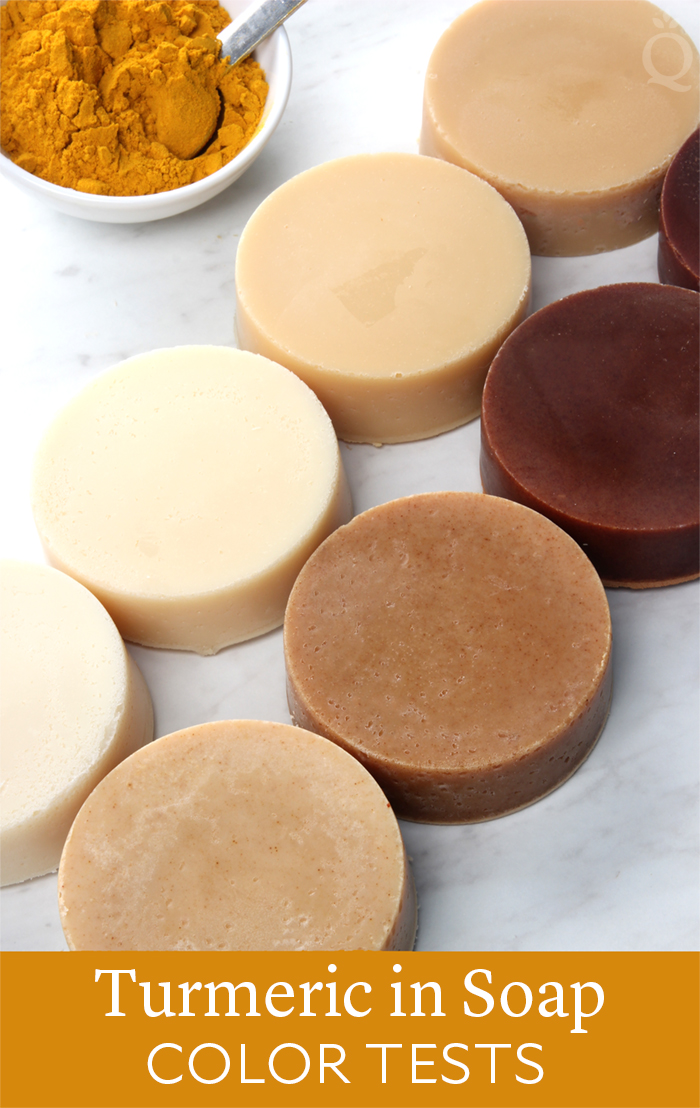
Turmeric is a bright yellow powder commonly used in cooking, dyeing fabrics, and beauty products. It gives cold process soap a range of color from soft yellow to burgundy depending on how much is used. Turmeric can be added directly to cold process soap at trace, or it can be infused with oil.
If you’re curious how to incorporate turmeric into your cold process soap recipe, this post is here to help. We tested adding the turmeric powder to soap versus a turmeric oil infusion. The soaps in these experiments were gelled to help the color pop.
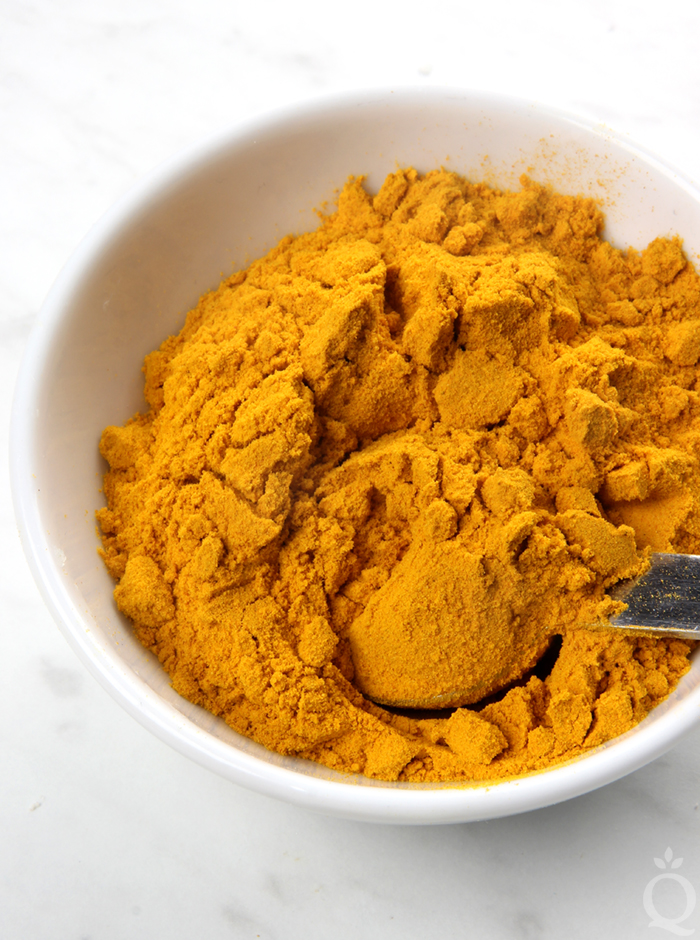
First, let’s review how to infuse soapmaking oils. Infusing oil with herbs and powders is a simple process. To avoid potential contamination by bacteria, completely dry herbs and powders are always recommended. A usage rate of at least 2 tablespoons of herbs for every 4 ounces of oil is common. For a stronger color, use 1 tablespoon of herbs or powder per ounce of oil.
The type of oil is up to you. In this instance, we used sweet almond oil. Liquid oils are recommended to prevent hardening during the infusion process. If the purpose of your infusion is color, a light-colored oil is recommended. If you make large batches, an oil with a longer shelf life is best. Learn more about various soapmaking oils here.
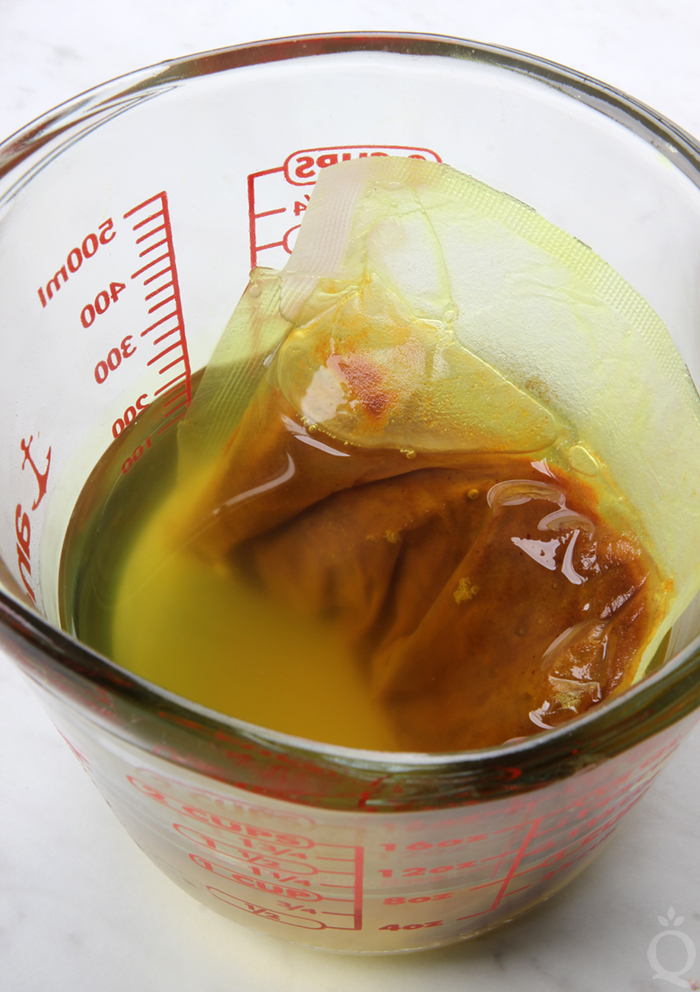
For this turmeric infusion, we wanted the color to be nice and strong, so we used 1 tablespoon of turmeric per ounce of oil. In this instance, that meant 6 tablespoons of turmeric for 6 ounces of sweet almond oil.
Place the turmeric powder into the Large Sealable Tea Bag, and use an iron to seal it shut. Measure 6 ounces of sweet almond oil (or oil of your choice) into a heat-safe container. Heat the oil in the microwave using 20-to 30-second bursts until it reaches about 140° F. Be careful when removing the container from the microwave. Place the turmeric into the hot oil.
Allow the turmeric to stay in the oil for 2-3 hours. Then, microwave the container for 30-60 seconds until the oil is hot again. Keeping the oil warm or hot during this process allows the turmeric to color it faster. You could also use a Crock-Pot, as demonstrated here. After the turmeric and oil have infused for at least 6 hours, remove the turmeric and gently squeeze out excess oil. The oil is now ready to use! Handle with care, because turmeric-infused oil can stain various surfaces.
Below, you can see how the turmeric-infused oil behaves in cold process soap when added at trace, giving it a very soft, orange color. The soap below did go through gel phase, which helps the color to become more saturated.
Turmeric Infusion in Cold Process Soap
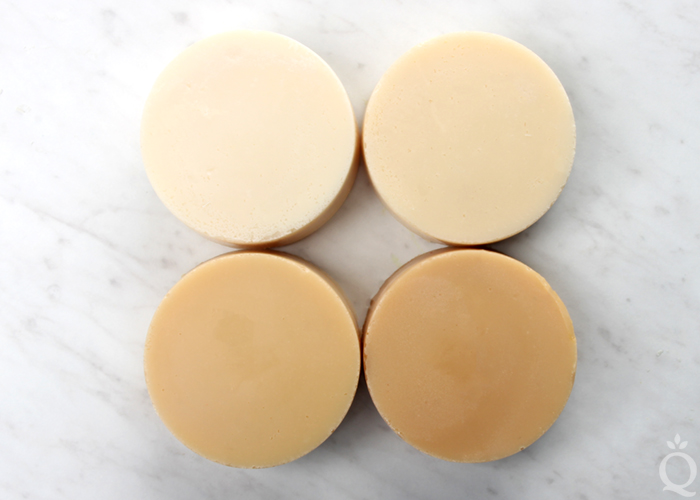
Top row, left to right: 1 tsp. turmeric infusion per pound of soap, 2 tsp. turmeric infusion per pound of soap
Bottom row, left to right: 4 tsp. turmeric infusion per pound of soap, 8 tsp. turmeric infusion per pound of soap
We also tested adding turmeric powder directly to the soap at trace. The powder was dispersed in sweet almond oil to help get rid of clumps, with a rate of 1 teaspoon of turmeric powder into 1 tablespoon of oil. To clarify, the results below are not 1 teaspoon of dispersed turmeric. Rather, we dispersed 1 teaspoon of turmeric and added the entire dispersion into 1 pound of soap.
Dispersed Turmeric Powder in Cold Process Soap
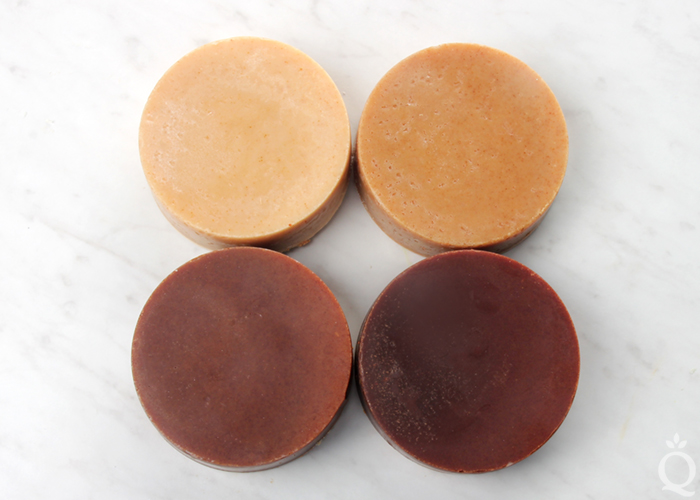
Top row, left to right: 1 tsp. turmeric per pound of soap, 2 tsp. turmeric per pound of soap
Bottom row, left to right: 4 tsp. turmeric per pound of soap, 8 tsp. turmeric per pound of soap
You can see that adding turmeric powder into cold process soap batter adds a deeper color to the soap than the turmeric infusion. The turmeric infusion did give the bars a smooth color, without speckles. How do you like to incorporate turmeric into your cold process soap?
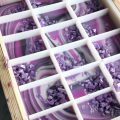
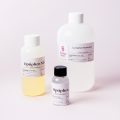

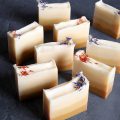
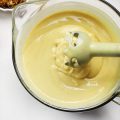
Hi, I was wondering what your thoughts are re: infusion with oil vs adding the product directly to the soap batter (before pouring into moulds). Is there a reason why it would be better to infuse with oil rather than (1) infuse with water or (2) just adding directly to soap mix? Thanks!
We have note tried infusing in water so I’m not sure how that would work. Infusing the turmeric first in oil will help prevent clumping and also results in a deeper color.
I have been making a turmeric soap for the past couple of years, but I have always put my turmeric directly into my lye water. I have found this to be very successful. Is there a reason why you wouldn’t do that, or just preference?
We have not tested that technique before. We have added Natural Indigo Powder directly to the lye water so I don’t see why it wouldn’t work.
Wouldn’t the lye kill all the benefits of using turmeric?
There is some debate over that. Some people believe it would though some believe many of the properties are sustained throughout the lye reaction.
Hello,I am so filled with knowledge every time I read from you.thanks so much.pls,is tumeric used for coloring only ,don’t know if you have any idea if the good nutrients in the tumeric survive saponification.
We are only using the turmeric for a coloring in this recipe. I’m not 100% sure how much of its properties would survive saponification like you mentioned.
Hello and Thank You for all of the wonderful training and information you provide..your site is awesome for a new soap maker like me. I recently made turmeric infused oil using turmeric root and olive oil. I then used it in a cp soap with a sandalwood scent. I soaped it around 95-100 degrees F. Half of the soap was made with almond milk in the lye water. Everything went well and the turmeric gave it a great orange color. Unfortunately after about a week out of the mold it had changed to a gray dull color and all my scent is gone. I have no idea what happened. The only other additive I used was a little Kaolin Clay as I read it might help to keep the scent.
I am currently wanting to make some fall soaps and especially pumpkin pie soap. The batch I just made lost it’s color as well and is gray; That had pumpkin puree in the lye water and some added at trace. I used orange mica pigment, and the Kaolin Clay. I used a pumpkin FO that had some vanilla in it but I put that in a separate part of the soap and poured them in a swirl so I hoped not to have my orange part impacted by it.
Any advice appreciated and if you can suggest FO and colors for this soap….Thank you!
That may be due to several factors, including temperature or fragrance oil. Did the sandalwood scent have vanilla? How hot were your lye and oil, and how did you store the soap after? Let me know and I can offer some tips.
sorry I have to comment under this cos I couldn’t get a place to type mine personally.
From your reply does vanilla fragrance has anything to do with trace nd does it automatically change the trace texture of your soap cos each time i work with it , I experience this problems.
We haven’t had that problem with our Vanilla Select Fragrance Oil, but it does discolor. The issue could be from the fragrance you are working with. Is it a Bramble Berry fragrance? If so, which one?
Hi Bramble Berry Team!
Love tumeric as a colorant! Makes the nicest gold infusions.
Hope you can help, if i make a warm tumeric infusion (1oz spice /15oz olive), and strain the infusion before usage (no spice in soap) how can i calculate the residual amount of tumeric (%) in my infused oil? I can’t find the calculation process anywhere when the herb/spice is stained out. You may want to try parsley, it makes a lovely green..
Thank you!
I’m not entirely sure how to calculate that percentage. Are you wanting to know for labeling purposes?
Hi, I was unable to comment on the “how to substitute oils” post, which would be more relevant, so here’s my question. Btw I’m trying the turmeric soap tomorrow! Natural colourants are the best!
My question – do you have a recipe using ghee? Id like to not use palm oil and as ghee is cheap and plentiful in India, I was wondering what the best recipe was? Like Coconut oil it stays solid here in the winter but is liquid in the summer.
Which leads to my 2nd question – as the coconut oil is liquid in the summer at room temperature, will it affect the soap? Do I need to change the recipe? Or age for longer?
We haven’t worked with ghee, so I don’t know a lot about it. However, babassu oil can be used in place of palm oil: https://www.brambleberry.com/Babassu-Oil–P6807.aspx
You can also add a hard oil like cocoa butter up to 15% to add firmness like palm oil does. Coconut oil or tallow up to 33% work as well. Read more about common oils and what properties they add to soap here: http://www.soapqueen.com/bath-and-body-tutorials/tips-and-tricks/free-beginners-guide-to-soapmaking-common-soapmaking-oils/
This post on substituting oils has some great information too: http://www.soapqueen.com/bath-and-body-tutorials/tips-and-tricks/how-to-substitute-oil-in-cold-process-recipes/
Sodium lactate is helpful as well. It helps the bars unmold more quickly. You can add 1 tsp. of sodium lactate per pound of oils to your cooled lye water. Read more in the Sunday Night Spotlight: Sodium Lactate: http://www.soapqueen.com/bramble-berry-news/sunday-night-spotlight-sodium-lactate/
If your coconut oil is already liquid, that means you can skip the extra step of melting it in the microwave. If your house is hot enough for that oil to be liquid, you may want to run a fan or dehumidifier over the soap as it cures. The bars cure best in a cool, dry place.
Hi Kelsey,
Can the turmeric powder be used as a colorant in bath bombs?
If so, does is have a strong scent?
Thank you for putting out such helpful content!
My worry with the turmeric is that it may not mix into the water, which can cause transfer and possible staining on the tub. You may try a bath bomb in a bucket you’re not too worried about getting dirty. You can also see how strong the scent is that way.
It may help to add .1 oz. of polysorbate 80 per cup of bath bomb mixture to try and emulsify the turmeric with the water: https://www.brambleberry.com/Polysorbate-80-P4438.aspx
Can I hot infuse other herb powers/dried plants using this microwave method? I am currently cold infusing but I want quicker results without having to buy a crockpot. I know it’s cheap but I just don’t want to…thanks!
Yes, you can use the microwave method for other powders and herbs. It’s a nice quick way to infuse the oil.
How would you adapt the Tumeric Soap recipe if you do not want to use the Quick Mix?
You can use any recipe you like and color it with turmeric. How are you wanting to adapt the recipe? I can offer some tips.
I am a new soap maker and I’m curios as to whether or not you can add things like cloves or ginger to the lye in or to pull the scents out of them instead of using oils.
You can infuse oils with herbs like lavender, calendula, etc. This post tells you how: https://www.soapqueen.com/bath-and-body-tutorials/tips-and-tricks/how-to-infuse-oils-with-a-crock-pot/
For the clove and ginger, you may want to make a small test batch and try it on your skin. Those ingredients can be irritating in larger doses, so you’ll want to look out for that. If you feel any I would recommend skipping it.
Also, infused oils add subtle color, but they add little to no scent. For the best results, we recommend fragrance or essential oils.
Essential oils: https://www.brambleberry.com/Essential-Oils-C157.aspx
Fragrance oils: https://www.brambleberry.com/Fragrance-Oils-C161.aspx
Find out how much to add with our Fragrance Calculator: https://www.brambleberry.com/Pages/Fragrance-Calculator.aspx
-Kelsey with Bramble Berry
I made my tumeric soap and turned coofee brown, I don’t know if is because I add lactic acid to it,or the lavender essential oil I add,and the soap is very soft, I used coconut oil and olive oil,please enlighten me more on this
How did you prepare the soap, was it cold or hot process? How did you store it? What temperatures were your lye and oils, and how much turmeric did you use? Let me know and I can help you troubleshoot.
-Kelsey with Bramble Berry
It’s because turmeric turns into reddish brown when it gets contact with an acid or strong base. Since NaOH is a strong base this happens naturally. This will not happen in melt and pour base since all NaOH is already neutralized.
Hope it helps.
Does tumeric leave an odor?
Because you’re using a small amount to color the soap, it will be very subtle or not noticeable in the final bars, especially if you’re using a fragrance or essential oil.
-Kelsey with Bramble Berry
Hi,
Thank you so much for doing this test and sharing it with everyone. I’ve been curious about this and *TADA!* the information pops up 9 days old! Like BB was reading my mind 🙂
And, thanks to everyone who asked great questions!
Love the blog
Oh that’s awesome, perfect timing! 🙂
-Kelsey with Bramble Berry
When I use almond oil, my skin got acne. What should I do?
tnx for your nice blog
Everyone’s skin reacts differently to certain oils. I would recommend to stop using the almond oil and talk to a dermatologist about the best oils for your skin type.
-Kelsey with Bramble Berry
I’ve put turmeric powder directly into cold process with a really lovely sandalwood-rose-neroli fragrance and had it turn a pretty gold tone. I love using turmeric infusion and powder in my soaps and I plan on bringing the colorant back for the autumn soap line I’m doing this year (with a great ginger-cinnamon-clove essential oil blend)!
The golden color with that scent blend sounds amazing – very warm and comforting. 🙂
-Kelsey with Bramble Berry
Love the color. I’d like to try the darkest color but was wondering what the longevity of these colors are in cp. How long will the color last?
Turmeric is a fairly stable colorant, but as with all natural colorants you may notice some fading in a few months. Make sure to store the soap in a cool, dry place away from direct sunlight to keep that color brighter for longer.
Learn more about storing soap here: http://www.soapqueen.com/bath-and-body-tutorials/tips-and-tricks/how-to-store-handmade-bath-products/
-Kelsey with Bramble Berry
Thank you for doing this! I just bought some turmeric from you to use in soap making and was wondering how much to use. It looks like 3t/pound would give it the most turmeric-like color. I look forward to trying it.
Have fun! 🙂
-Kelsey with Bramble Berry
Thank you for the useful information! Question: at what concentration of turmeric infusion/direct dispersion does it start staining skin/washcloth?
I’m not sure of the exact rate, but in larger concentrations it can transfer to the skin or clothes. With the darkest bar pictured (8 tsp. per pound) it didn’t stain the skin but when the wet bar is placed on your sink there will be some transfer. It does wash away fairly easily though. To avoid any transfer, use turmeric in smaller amounts. It also helps to lay out newspaper or other coverings on tables and counters to prevent any possible stains during the soaping process.
-Kelsey with Bramble Berry